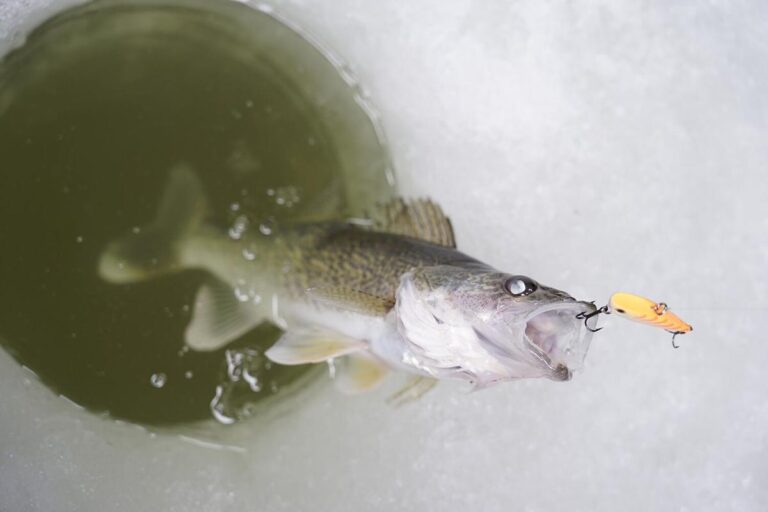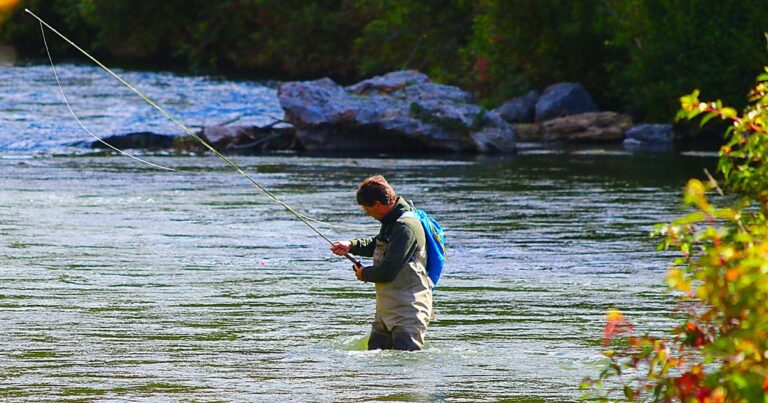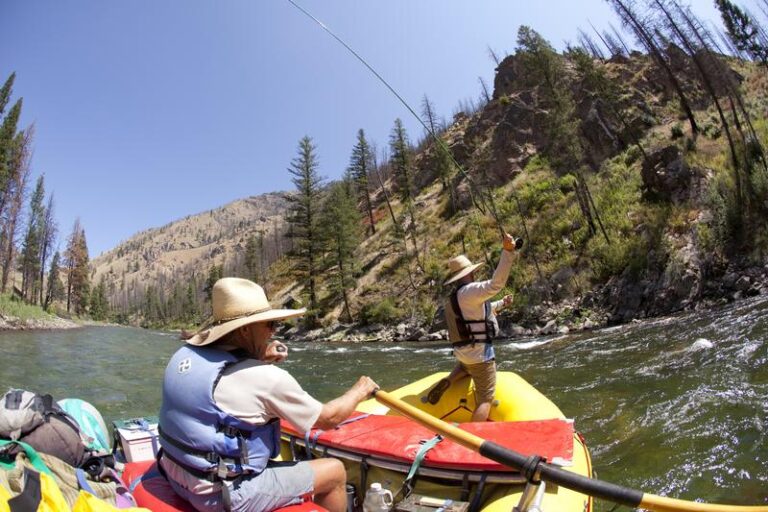Understanding river currents is key for successful fishing. In order to catch the most fish possible, anglers need to comprehend how the water flows and affects aquatic life.
For many people, fishing is a favorite pastime that allows them to experience the great outdoors while hopefully reeling in a big catch. However, fishing isn’t just about luck or throwing a line in the water and hoping for the best.
Anglers who take the time to understand river currents can dramatically increase their chances of success by knowing where fish are likely to be found. River currents play a critical role in determining where fish move, rest and feed—all of which can have a significant impact on whether someone catches anything or not. With some careful observation and study, anyone can learn how to recognize and interpret river currents, giving them an edge when it comes to fishing.

Credit: minnkota.johnsonoutdoors.com
Understanding River Currents For Successful Fishing
What Are River Currents And How They Affect Fishing?
Fishing in rivers can be a challenging but rewarding experience, and understanding river currents is essential for a successful catch. River currents are the movement of water in a river, and they influence the behavior of fish. The strength and direction of the river current play a significant role in where fish swim, feed, and hide.
- Fish tend to gather in areas where the current is slower, calmer, and deeper, making it easier to swim and conserve their energy.
- In areas where the current is faster, fish will swim against the flow, making it harder for them to swim and feed.
The Different Types Of River Currents And Their Effects On Fish Behavior
There are different types of river currents, and each affects fish behavior differently.
- One of the common types of river currents is the surface current, which flows on the surface of the water. The surface current often carries leaves and debris, which can attract fish looking for shelter or food.
- Turbulent currents, also known as eddies, are created when water flows over obstructions such as rocks. Eddies provide a slower, calmer area for fish to swim, which can attract them to the area.
- Undercurrents are strong, fast currents that flow underneath the surface of the water. Fish may use these undercurrents to swim faster or hide from predators.
Understanding the different types of currents and how they affect fish behavior can help you choose the best fishing spot.
Factors That Influence River Currents And How To Spot Them
Several factors influence river currents, and being able to spot them can help you find the best fishing spot.
- The slope of the surrounding land influences the river current. Similarly, steeper slopes lead to stronger currents, while gentler slopes lead to slower currents.
- Weather conditions such as wind and rainfall can impact river currents. Heavy rainfall can cause the water to rise and create stronger currents, while wind can create surface currents.
- Obstructions such as rocks, logs, and dams affect the flow of the river current. These obstructions can cause eddies or undercurrents that can attract fish.
By keeping an eye on surrounding land, weather patterns, and obstructions, you can identify areas of fast and slow currents to find the best fishing spot.
Tips For Reading And Interpreting River Currents And Their Impact On Fishing
Reading and interpreting river currents can significantly improve your chances of a successful fishing trip. Here are some tips to help you read and interpret river currents effectively.
- Look for areas of slower-moving water. Fish prefer to swim and feed in calmer waters.
- Monitor the direction of the current. Fish tend to swim against the flow for better resistance, so it’s best to cast your line up-current.
- Pay attention to any obstructions in the river. These often create eddies that can attract fish, so it’s worth casting your line near these areas.
- Experiment with different bait and lures. Fish may respond differently to certain lures depending on the speed and direction of the current.
Understanding river currents and how they affect fish behavior is crucial for a successful fishing trip. By spotting areas of fast and slow-moving water and using the right bait and lure, you can increase your chances of a fruitful catch.
Tactics And Strategies For Fishing In River Currents
Understanding River Currents For Successful Fishing
As an angler, understanding river currents is essential for catching fish. Fishing in river currents requires different tactics and strategies, and using the right gear and techniques can help you land the big ones. In this blog post, we will be discussing the best practices for fishing in various river currents, essential fishing gear for river current fishing, how to adjust your fishing techniques to different water speeds, and tips for landing big catches in different river currents.
Best Practices For Fishing In Various River Currents
Fishing in different river currents requires different techniques and approaches. Here are some best practices for fishing in various river currents:
- Slow-moving currents: Fish are attracted to cover and structure, so look for places where there are rocks, logs, or other obstructions in the water. Use a slow and steady retrieve to catch fish in these currents.
- Fast-moving currents: When fishing in fast-moving currents, use lures that mimic the natural prey of the fish, such as minnows or small fish. Cast upstream and let the current carry your lure downstream towards the fish.
- Eddies: Eddies are calm spots in the water created by obstructions. Fish often congregate in these areas, so cast your line into the eddy and let it drift downstream. Use a slow retrieve to entice fish in these areas.
Essential Fishing Gear For River Current Fishing
Having the right fishing gear is essential when fishing in river currents. Here are some essential gear you’ll need:
- Rod and reel: Choose a rod that is suitable for the type of fish and current you’ll be fishing in. A longer rod can help you cast further, while a shorter rod gives you better control in fast currents. Use a reel with a high gear ratio to quickly retrieve your line in fast-moving currents.
- Lures: Use lures that mimic the natural prey of the fish you’re trying to catch. Choose lures that match the color and size of the baitfish in the area you are fishing.
- Sinkers: In fast-moving currents, use sinkers to keep your bait in place. Use lighter sinkers in slow-moving currents to avoid scaring the fish.
- Fishing line: Use a strong fishing line that can withstand the force of the current. Monofilament line is a good choice for slow-moving currents, while braided line works best in fast-moving currents.
How To Adjust Your Fishing Techniques To Different Water Speeds
When fishing in river currents, adjusting your fishing techniques to different water speeds can make a big difference in your catch rate. Here are some tips for adjusting your techniques:
- Slow-moving currents: Use a slow and steady retrieve to entice fish in slow-moving currents. Cast your line near cover and structure where fish are likely to be hiding.
- Fast-moving currents: Cast upstream and let your lure drift downstream towards the fish. Use a quick retrieve with occasional pauses to mimic the movement of natural prey.
- Eddies: Cast into the eddy and let your line drift downstream. Use a slow retrieve and vary the speed to entice fish in the area.
Tips For Landing Big Catches In Different River Currents
Fishing in river currents can produce big catches, but landing them requires the right techniques. Here are some tips for landing big catches in different river currents:
- Slow-moving currents: Set the hook firmly when you feel a bite, and reel in slowly to avoid ripping the hook out of the fish’s mouth. Keep the rod tip up to keep tension on the line and prevent the fish from escaping.
- Fast-moving currents: Use a high gear ratio reel to quickly retrieve your line and set the hook firmly when you feel a bite. Keep the rod tip up to keep tension on the line and avoid breaking the line.
- Eddies: Use a slow retrieve and vary the speed to entice fish in the eddy. When you feel a bite, set the hook firmly and reel in slowly to avoid losing the fish.
Now that you know the tactics and strategies for fishing in river currents, it’s time to hit the water and put your newfound knowledge to the test. Remember to use the right gear and techniques for the type of current you’re fishing in and adjust your approach as needed.
With practice and patience, you’ll be reeling in big catches in no time.
Conclusion
Understanding river currents is essential for any angler who hopes to have success on the water. By taking the time to study the specifics of river flow, an angler can pinpoint the areas of a river that are most likely to hold fish and adjust their presentation accordingly.
From eddies to riffles, understanding the nuances of current flow can make all the difference. However, it’s important to remember that river currents are constantly changing, so staying observant and adaptable is key. With a solid understanding of river currents and a willingness to learn and adjust, any angler can increase their chances of a successful day on the water.
So next time you hit the river, pay attention to the way the water is moving – it just might lead you to your next big catch.






